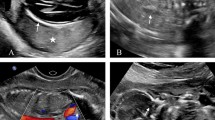Abstract
Objective
To review perinatal Radial Ray Anomaly (RRA) cases born at the National Institute of Perinatology, Mexico, and to reveal the heterogeneous diagnoses of these patients.
Methods
All patients with RRA over a 18 mo period were included; 4/15 were detected prenatally and 11/15 postnatally. Karyotype was performed for all patients with bilateral RRA; and chromosomal breakage analysis, when the karyotype was normal.
Results
Fifteen RRA patients were identified: one with trisomy 18, three with an isolated defect, six with monogenic disease, four with a genetic association and one with diabetic embryopathy. Five were stillborn and two died during the early neonatal period; all of whom presented with multiple defects. Three of the live born patients and one stillborn with multiple defects had Fanconi anemia. RRAs carry a high perinatal mortality rate (47%) when they occur in association with other defects.
Conclusions
The assessment of these patients needs to involve the combined use of ultrasound, clinical, genetic, cytogenetic and molecular testing. The present results indicate that the chromosome breakage test should always be performed to rule out Fanconi anemia in this group.


Similar content being viewed by others
References
Mancuso A, Giacobbe A, De Vivo A, Fanara G, Cocivera G. Prenatal identification of isolated bilateral radial dysplasia. J Clin Ultrasound. 2009;37:175–8.
Kennelly MM, Moran P. A clinical algorithm of prenatal diagnosis of radial ray defects with two and three dimensional ultrasound. Prenat Diagn. 2007;27:730–7.
Ito T, Handa H. Deciphering the mystery of thalidomide teratogenicity. Congenit Anom (Kyoto). 2012;52:1–7.
Waller DK, Shaw GM, Rasmussen SA, et al. Prepregnancy obesity as a risk factor for structural birth defects. Arch Pediatr Adolesc Med. 2007;161:745–50.
Jones KL. Recognizable patterns of malformation. In: Hummel T, Davis KJ, editors. Smith’s recognizable patterns of human malformation. Philadelphia: Elsevier Saunders; 2006. p. 362–5.
Sasaki MS, Tonomura A. A high susceptibility of Fanconi’s anemia to chromosome breakage by DNA cross-linking agents. Cancer Res. 1973;33:1829–36.
German J, Schonberg S, Caskie S, Warburton D, Falk C, Ray JH. A test for Fanconi’s anemia. Blood. 1987;69:1637–41.
Robert E, Harris J, Källén BA. The epidemiology of preaxial limb malformations. Reprod Toxicol. 1997;11:653–62.
Pakkasjärvi N, Koskimies E, Ritvanen A, Nietosvaara Y, Mäkitie O. Characteristics and associated anomalies in radial ray deficiencies in Finland--a population-based study. Am J Med Genet A. 2013;161A:261–7.
Cox H, Viljoen D, Versfeld G, Beighton P. Radial ray defects and associated anomalies. Clin Genet. 1989;35:322–30.
Pajkrt E, Cicero S, Griffin DR, van Maarle MC, Chitty LS. Fetal forearm anomalies: prenatal diagnosis, associations and management strategy. Prenat Diagn. 2012;32:1084–93.
García-de Teresa B, del Castillo V, Molina B, Frías S. Diagnóstico clínico y de laboratorio de la anemia de Fanconi. Acta Pediatr Mex. 2012;33:38–43.
Vetro A, Iascone M, Limongelli I, et al. Loss-of-function FANCL mutations associate with severe Fanconi anemia overlapping the VACTERL association. Hum Mutat. 2015;36:562–8.
Schifferli A, Kühne T. Fanconi anemia: overview of the disease and the role of hematopoietic transplantation. J Pediatr Hematol Oncol. 2015;37:335–43.
Auerbach AD. A test for Fanconi’s anemia. Blood. 1988;72:366–7.
Eiler ME, Frohnmayer JDD, Frohnmayer LMSW, Larsen K, Owen J. Fanconi anemia guidelines for diagnosis and management. Eugene: Fanconi Anemia Research Fund, Inc.; 2008. p. 41–2.
Frohnmayer D, Frohnmayer L, Guinan E, Kennedy T, Larsen K. Hand and arm abnormalities. In: Hays L, editor. Fanconi anemia: guidelines for diagnosis and management. Eugene: Fanconi Anemia Research Fund Inc.; 2014. p. 99–122.
Vendramini S, Richieri-Costa A, Guion-Almeida ML. Oculoauriculovertebral spectrum with radial defects: a new syndrome or an extension of the oculoauriculovertebral spectrum? report of fourteen Brazilian cases and review of the literature. Eur J Hum Genet. 2007;15:411–21.
Giampietro PF, Adler-Brecher B, Verlander PC, Pavlakis SG, Davis JG, Auerbach AD. The need for more accurate and timely diagnosis in Fanconi anemia: a report from the International Fanconi Anemia Registry. Pediatrics. 1993;91:1116–20.
Auerbach AD. Diagnosis of Fanconi anemia by diepoxybutane analysis. Curr Protoc Hum Genet. 2015;85:8.7.1–17.
Acknowledgments
The authors thank the parents of the patients for participating in the study and health professionals of the Radiology and Pathology Department.
Contributions
RS-M: Study design, data acquisition and wrote the manuscript; MA: Data acquisition, study design, wrote the manuscript, coordinated the study and will act as guarantor for the paper; AM: Data acquisition, and helped to write the manuscript; GR: Genetics studies; BM: Performed the chromosome breakage test and reviewed the final manuscript; SF: Reviewed the patients information, corrected the final manuscript and collaborated in the writing process; PG: Data acquisition.
Author information
Authors and Affiliations
Corresponding author
Ethics declarations
Conflict of Interest
None.
Source of Funding
None.
Rights and permissions
About this article
Cite this article
Sevilla-Montoya, R., Aguinaga, M., Martínez, A. et al. Heterogeneous Diagnoses Underlying Radial Ray Anomalies. Indian J Pediatr 84, 200–205 (2017). https://doi.org/10.1007/s12098-016-2270-4
Received:
Accepted:
Published:
Issue Date:
DOI: https://doi.org/10.1007/s12098-016-2270-4




